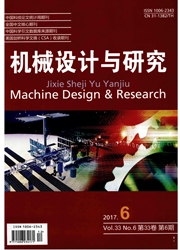

 中文摘要:
中文摘要:
为全面考察六维正交并联模拟台可能的误差源,同时避免微分及矢量法建模存在的大量偏导计算,将机构6个支链分别等效为相应的串联机构,根据机构支链的正交特征并结合运动学影响系数的原理建立了较为完备的误差模型。模型包含了铰链点自身加工误差、安装误差,定长杆误差及驱动误差在内的144个误差源。以定义的误差敏感性系数为指标,利用数值仿真分析了所有误差源对末端精度的影响程度,并据此将误差源分为三类:非敏感误差、非完全敏感误差和完全敏感误差。最后,说明了这三类误差在运动学标定过程中与识别参数确定及测量位姿选取的关系。
 英文摘要:
英文摘要:
To avoid the complexity of error modeling based on the method of differential or vector and include the errors as many as possible, the six chains of the simulation platform were regarded as the equivalent series mechanism, respectively. Thanks to the orthogonal feature of the chains and the principle of influence coefficients, the error model of the simulation platform was established. The joint manufacturing errors, instllation errors and actuation errors were taken into account in this model. According to the error sensitivity index, all the 144 errors were classified into three categories: non-sensitive errors, non-wholly sensitive errors and wholly sensitive errors. Finally, the relationship among the three categories of errors, the selected measuring pose and the calibration parameters was explained.
 同期刊论文项目
同期刊论文项目
 同项目期刊论文
同项目期刊论文
 A neuroendocrine-immune system inspired bio-network architecture and its simulation platform for com
A neuroendocrine-immune system inspired bio-network architecture and its simulation platform for com Enhanced interactive satisfying optimization approach to multiple objective optimization with preemp
Enhanced interactive satisfying optimization approach to multiple objective optimization with preemp Performance monitoring and diagnosis of multivariable model predictive control using statistical ana
Performance monitoring and diagnosis of multivariable model predictive control using statistical ana Steady-state target calculation for constrained predictive control systems based on goal programming
Steady-state target calculation for constrained predictive control systems based on goal programming The design of predictive control with characterized set of initial condition for constrained switche
The design of predictive control with characterized set of initial condition for constrained switche Satisfying optimization method based on goal programming for fuzzy multiple objective optimization p
Satisfying optimization method based on goal programming for fuzzy multiple objective optimization p Robust adaptive terminal sliding mode-based synchronised position control for multiple motion axes s
Robust adaptive terminal sliding mode-based synchronised position control for multiple motion axes s An interactive satisficing method based on alternative tolerance for fuzzy multiple objective optimi
An interactive satisficing method based on alternative tolerance for fuzzy multiple objective optimi Two-step interactive satisfactory method for fuzzy multiple objective optimization with preemptive p
Two-step interactive satisfactory method for fuzzy multiple objective optimization with preemptive p Intelligent decoupling control system inspired from modulation of the growth hormone in neuroendocri
Intelligent decoupling control system inspired from modulation of the growth hormone in neuroendocri 期刊信息
期刊信息
